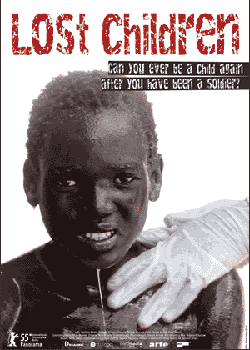
Lost Children (Germany/Uganda, 2005, Directors: Ali Samadi Ahadi, Oliver Stoltz, 98 minutes): All three of the films I saw today were about “children in peril” but none were more horrifying than this one. Northern Uganda has been caught up in civil war for almost twenty years. The rebels of the “Lord’s Resistance Army” make it their primary tactic to kidnap children from local villages, forcing them to fight in their army. Children as young as 8 are taught to kill with guns and knives, and those who don’t share in the atrocities are killed themselves, often by other conscripted children.
Catholic relief agency Caritas is running a reintegration centre for those children who manage to escape the rebel army. It is a formidable challenge. Often the children have physical injuries, either sustained in battle or in their harrowing escapes. The mental damage is much harder to repair. They often have nightmares, and are terrified of being reabducted. Their families are suspicious of them, and are also afraid of being targetted again by the rebels. In these circumstances, the social workers and doctors at the centre have their hands full.
We meet Jennifer, 14, who spent five years with the Lord’s Resistance Army, fighting government troops and terrorizing civilians, all the while being raped regularly as a commander’s concubine. And Opio, just 8 years old, describing how he bashed in a man’s skull with a rifle butt. Then there is sensitive Kelama, 13, who was forced to kill a woman in front of her child and who now can’t stop dreaming about her. All these children have a long road ahead of them, first reintegrating with their families and communities, and then hoping that the rebels don’t return for them.
It’s difficult to “rate” films like this, because they don’t really function as pieces of art. Instead, they fulfill another aspect of the documentary’s role, that of bearing witness. In that sense, this film is a clear-eyed look at some of the most horrifying crimes against children ever perpetrated. By making children do their killing for them, the so-called “Lord’s Resistance Army” have killed the childhoods of these children. As they piece together the shreds of their humanity, they are no longer children. What they will become is a mystery.
Information on helping the children here.
Coalition to Stop the Use of Child Soldiers
 (9/10)
(9/10)
 (8/10)
(8/10)
 (10/10)
(10/10)